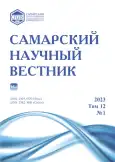Ecology and number dynamics of bezoar goats (Capra aegagrus Erxleben, 1777) in the Mrav Mountain range of Nagorno Karabakh Republic
- Authors: Hayrapetyan V.T.1, Minasyan H.J.2, Avagyan A.A.3, Ghazaryan A.S.4
-
Affiliations:
- Artsakh Republic Nature Protection Committee
- Ministry of Education, Science, Culture and Sport of Republic of Artsakh
- Hydrometeorology and Monitoring Center
- Yerevan State University
- Issue: Vol 12, No 1 (2023)
- Pages: 10-14
- Section: Biological Sciences
- URL: https://journals.rcsi.science/2309-4370/article/view/133936
- DOI: https://doi.org/10.55355/snv2023121101
- ID: 133936
Cite item
Full Text
Abstract
The mammal fauna of Nagorno Karabakh has 6 orders and 101 species. The three-dimensional location, geographical location and temperate climate characteristic of the mountainous country contributed to the formation of such diversity. For the first time this paper presents the distribution and dynamics of the number of bezoar goats (Capra aegagrus Erxleben, 1777), an ancient inhabitant of the northern, central and southern parts of Nagorno Karabakh, which is an important component of mountain ecosystems, in the Mrav mountain range. As a result of our long-term observations, we have found out the distribution areas of these animals in the Mrav mountain range, the reasons for their distribution in the mountains and their seasonality. We have found out that male and Bemale bezoar goats have their own preferences for slope curvatures, so females prefer to stay at 47° curvatures in winter, while males prefer to stay at 50–55° slopes. Meanwhile, the opposite phenomenon is recorded in summer. We have also studied the distribution of different sexes in the southern, eastern and northern slopes in winter and summer. We have registered the specifics of distribution above the sea level with vertical zoning. As a result of our observations, we have found out the changes and dynamics of the number of bezoar goats in the Mrav mountains, identified some reasons that negatively affect the growth and development of these animals.
Keywords
Full Text
##article.viewOnOriginalSite##About the authors
Vahram Torikovich Hayrapetyan
Artsakh Republic Nature Protection Committee
Author for correspondence.
Email: vahram76@mail.ru
doctor of biological sciences, deputy director
StepanakertHasmik Jhumshudovna Minasyan
Ministry of Education, Science, Culture and Sport of Republic of Artsakh
Email: as_minasyan@mail.ru
candidate of biological sciences, deputy minister
StepanakertArman Artashesovich Avagyan
Hydrometeorology and Monitoring Center
Email: avayan@bk.ru
candidate of biological sciences, deputy director
Armenia, YerevanAstghik Samvelovich Ghazaryan
Yerevan State University
Email: astbat@yahoo.com
candidate of biological sciences, associate professor of Zoology Department
Armenia, YerevanReferences
- Явруян Э.Г., Айрапетян В.Т. Дикие млекопитающие Карабаха (Насекомоядные, рукокрылые, грызуны, зайцеобразные). Степанакерт: Дизак Плюс, 2003. 124 с.
- Явруян Э.Г., Айрапетян В.Т. Дикие млекопитающие Карабаха (Хищные, копытные). Степанакерт: Дизак Плюс, 2003. 48 с.
- Айрапетян В.Т. Фауна млекопитающих Нагорно-Карабахской Республики: дис. … д-ра биол. наук: 03.00.08. Ереван, 2014. 380 с.
- Айрапетян В.Т., Арутюнян М.К., Явруян Э.Г. Рукокрылые Нагорного Карабаха (фауна, экология, география обитания). Степанакерт: Дизак Плюс, 2016. 211 с.
- Айрапетян В.Т., Григорян М.Р., Авакян А.А. Насекомоядные фауны Арцаха. Степанакерт, 2021. 168 с.
- Айрапетян В.Т., Арутюнян М.К., Явруян Д.Э., Маркарян Н.А. Красная книга животных Карабаха. Позвоночные. Ереван: Эдит Принт, 2012. 304 с.
- Магомедов М.-Р.Д., Ахмедов Э.Г., Яровенко Ю.А., Насрулаев Н.И. Безоаровый козел в Дагестане: популяционная организация и особенности экологии. М.: Товарищество науч. изд. КМК, 2014. 120 с.
- Introduction // Fernandez-Jalvo Y., King T., Yepiskoposyan L., Andrews P. Azokh cave and the Transcaucasian corridor. Cham: Springer, 2016. P. 1–26. doi: 10.1007/978-3-319-24924-7_1.
- Динник Н.Я. Звери Кавказа. Ч. I. Китообразные и копытные (Записки Кавказского отдела Императорского Русского географического общества. Кн. XXVII, вып. 1). Тифлис: Тип. К.П. Козловского, 1910. 249 с.
- Верещагин Н.К. Млекопитающие Кавказа. Л.: Изд-во Академии наук СССР. Ленингр. отд-ние, 1959. 704 с.
- Мнацаканян Б.П., Аракелян Ю.А. Водный баланс территории НКР и прилегающих территорий // Образование и наука в Арцахе. Вып. 5/6. Ереван, 2003. С. 65–66.
- Вейнгер Г.М. Популяция горалов Сихотэ-Алинского государственного заповедника // Труды Сихотэ-Алинского государственного заповедника. Вып. 3. Владивосток, 1963. С. 269–281.
- Новиков Г.А. Полевые исследования по экологии наземных позвоночных: учеб. пособие. Изд. 2-е изд., испр. и доп. М.: Советская наука, 1953. 503 с.
- Явруян Э.Г. Закавказский дикий баран: дис. … канд. биол. наук: 03.00.08. Ереван, 1969. 262 с.
- Явруян Э.Г. Численность и методы охраны дикого барана в Армении и Нахичеванской АССР // Копытные фауны СССР: экология, морфология, использование и охрана: докл. совещ. / отв. ред. акад. В.Е. Соколов. М.: Наука, 1975. С. 285.
- Даль С.К. Позвоночные животные Сарайбулагского хребта // Зоологический сборник Академии наук Армянской ССР. Вып. 3 / отв. ред. проф. А.А. Рихтер. Ереван, 1944. С. 5–46.
- Darmon G., Calenge C., Loison A., Jullien J.-M., Maillard D., Lopez J.-F. Spatial distribution and habitat selection in coexisting species of mountain ungulates // Ecography. 2012. Vol. 35. P. 44–53. doi: 10.1111/j.1600-0587.2011.06664.x.
- Papaioannou H., Sgardelis S., Chondropoulos B., Vassilakis D., Kati V., Dimopoulos P. Demographic characteristics, seasonal range and habitat topography of Balkan chamois population in its southernmost limit of its distribution (Giona mountain, Greece) // Journal of Natural History. 2015. Vol. 49, iss. 5–8. P. 327–345. doi: 10.1080/00222933.2013.869365.
- Магомедов М.-Р.Д., Ахмедов Э.Г., Насрулаев Н.И. Закономерности пространственной организации популяции безоарового козла Capra aegagrus Erxleben (Artiodactyla) в условиях Восточного Кавказа // Зоологический журнал. 2002. Т. 81, № 8. С. 1008–1016.
- Айрумян К.А., Гаспарян К.М. Редкие копытные и хищные млекопитающие Армении // Редкие виды млекопитающих фауны СССР и их охрана: сб. мат-лов / отв. ред. В.Е. Соколов. М.: Наука, 1973. С. 35–42.
- Бородатый козёл – Carpa aegagrus Erxleben., 1777 // Соколов В.Е., Темботов А.К. Млекопитающие: Копытные (сер. «Позвоночные Кавказа»). М.: Наука, 1993. С. 338–372.
Supplementary files









